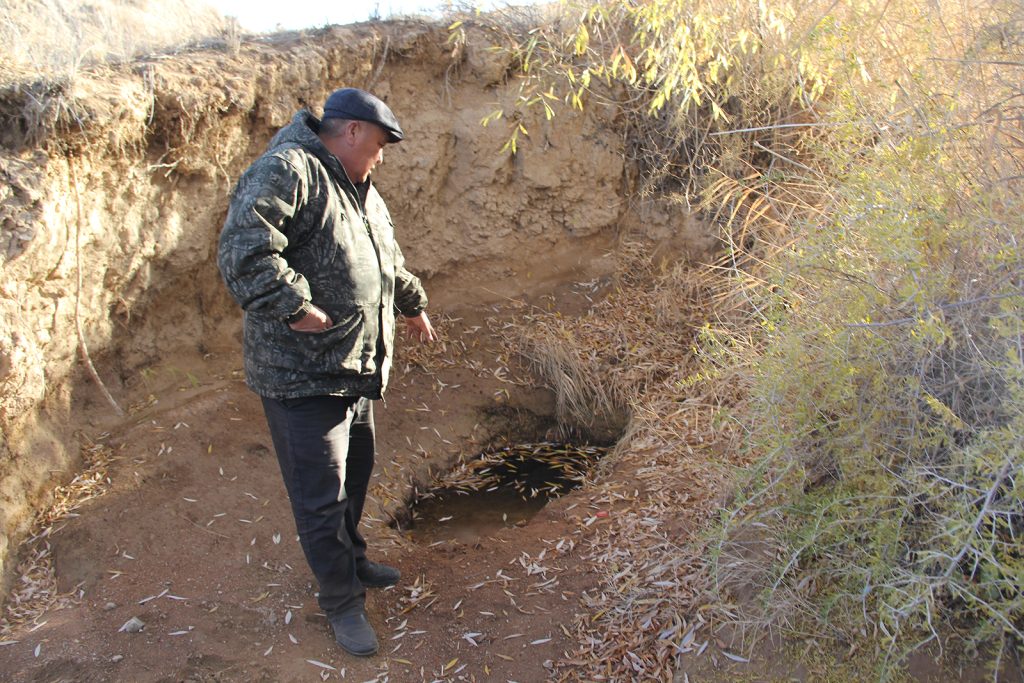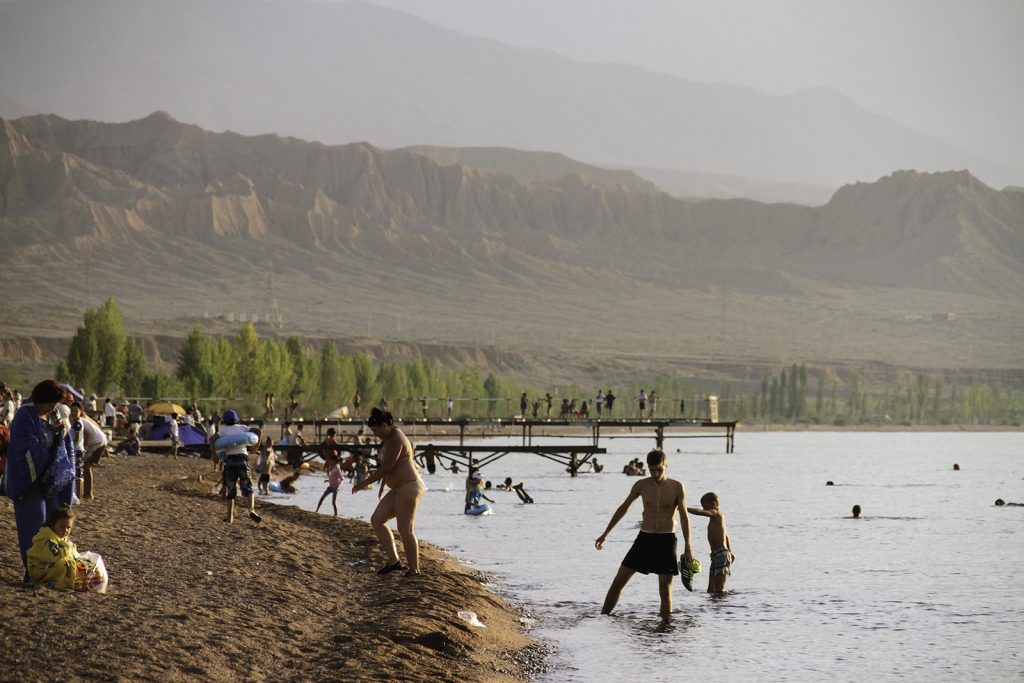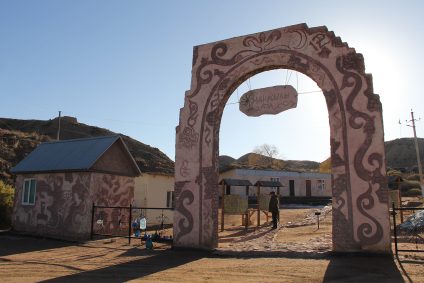BOKONBAYEVO, Kyrgyzstan (RNS) — On a crisp afternoon in November, Bakyt Choitonbaev picked his way along a narrow trail, pushing through spiky shrubs of ephedra before stopping at a small pool of bright green water and pointing out well-worn patches of dirt where visitors kneel to pray.
Pilgrims, Choitonbaev explained, come from around Kyrgyzstan to this spring and half a dozen others nearby to seek healing from illnesses or help bearing children.
This community leader lives in nearby Bokonbayevo, a town of 14,000 people at the foot of the snowcapped Tian Shan mountains in this central Asian country. For the past seven years, he said, he has noticed less and less water in the springs, a decline he attributed to both lower rainfall and to the constant flow of visitors who drink the water or bottle it for its sacred properties.
The springs are just one of numerous sites with religious or spiritual significance in this region that are being affected by human impacts on the environment, from development to climate change. “When the springs disappear, that causes pain, of course,” Choitonbaev said.

Known as Manzhyly-Ata, after a holy man buried nearby, the springs are located along the shores of Issyk Kul, the 10th-largest lake in the world; its name translates to “warm water” as its slight salinity prevents it from freezing over even in the depths of winter. It has also been called the world’s “third eye,” partly because of its curved shape, but also for its spiritual power as a source of life in an otherwise arid region.
The shores of Issyk Kul hold are more than 130 sacred sites, according to Aigine CRC, a Kyrgyz nonprofit that published an inventory of spiritual landmarks in the region in 2009, defining a sacred site as anything from a natural feature — a tree, mountain peak, hot spring or the lake itself — to a tomb of an important person. These places often blend elements of Tengriism, an ancient traditional belief system that centers reverence for nature, with Islamic spirituality introduced to the region between the eighth and 12th centuries.
Issyk Kul and the sacred places in the area also play a central role in “kyrgyzchylyk,” or Kyrgyz traditional knowledge, which incorporates these spiritual elements into national identity.
For centuries, Issyk Kul’s remoteness protected it and fostered its sense of sacredness. “There’s no separation between nature and culture, between people and nature,” said Aibek Samakov, a Kyrgyz researcher who helped document the sacred sites and record local legends and beliefs for Aigine CRC.
There’s no separation between nature and culture, between people and nature.
All of these beliefs are threatened by the lake’s shrinkage. The waterline has dropped by 90 centimeters, or nearly 3 feet, since 2011, according to the Institute for Water Problems of the Kyrgyz National Academy of Sciences. It’s not only climate change, or even devotees dipping into the springs. Much of the shortfall can be blamed on farmers who divert the flow of multiple rivers that feed into the lake to irrigate their fields and on unregulated groundwater pumping that draws down the water supply from below.
But it’s undeniable that the weather is growing increasingly hotter and drier, resulting in less rain and more evaporation. Average annual temperatures in Kyrgyzstan have increased by 1.3 degrees Celsius this century.
Little research has been done on how these environmental factors might be affecting sites such as Manzhyly-Ata. Local religious leaders claim the springs’ slow disappearance is due to disrespect from crowds of tourists who flock to the site for relaxation or entertainment instead of spiritual reasons, Samakov said.
“They don’t come seeking some cure or seeking peace … so what they do is a visit, but not a pilgrimage per se,” Samakov said. “That’s why the sacredness of the site was retreating.”
Sacredness, or “kasiet” in Kyrgyz, can apply to both people and places, Samakov explained; visiting sites imbued with kasiet is believed to help people replenish or discover the kasiet within themselves. In turn, sincere pilgrims boost a place’s kasiet; neglecting its spiritual nature or using it for other means causes the kasiet to migrate elsewhere.
Tourists are not the first to desecrate the lake in the eyes of locals. Under the staunchly secular Soviets, pilgrimage sites such as Manzhyly-Ata were fenced off to prevent spiritual visitors; officials even bulldozed trees or graves, Choitonbaev noted.
In the 1990s, after Kyrgyzstan and its Central Asian neighbors gained independence and the most severe restrictions on religious expression were lifted, a flood of missionaries from Muslim countries such as Pakistan and Saudi Arabia arrived, importing a more rigid view of Islam. Any sacred sites competing with the holy cities of Mecca and Medina were deemed un-Islamic.

Samakov recalled one incident near the town of Tokmok where an angry crowd tried to cut down several sacred trees, accusing the people visiting them to pray of engaging in “shirk,” or polytheism, considered the worst sin in Islam.
The latest threats to the area are development and industry. Locals have mobilized to protest a plan to mine uranium along the lake, fearing the work would pollute the water with radioactive waste. More recently, three French companies signed an agreement with the government to invest billions in an “Eco-City” on the shoreline, feeding criticism that the government cares more about attracting foreigners than preserving the lake’s unique ecology, despite its designation as a UNESCO Biosphere Reserve.
In his work for Aigine CRC, Samakov recorded a folk legend that said Issyk Kul was created when a woman washed her child’s dirty diapers in a sacred spring, causing a devastating flood. “And now, there are many people who are polluting the lake, littering its shores, selling the lake for money,” Azim Jakshylykova, a traditional practitioner, told Samakov. “If people continue maltreating the sacred lake like this, it will expand again and drown all the villages and towns around it.”
To counteract the ecological threats to Issyk Kul, Choitonbaev founded a nonprofit focused on developing sustainable tourism and convinced the regional government to protect 200 acres in and around the Manzhyly-Ata springs as a biocultural park. He put out a call for scientists to study the area’s unique flora and fauna before the expected completion of a new road around the lake brings throngs of tourists to the area this year, potentially damaging the ecosystem.
Safeguarding the environment, he believes, goes hand in hand with upholding traditional spiritual beliefs.
“There is only one religion,” Choitonbaev said, “and it is ecology.”
Latest Articles
-

American Civic Life
Once Protected by its Remoteness, a Sacred Lake in Kyrgyzstan is Threatened by Change
April 26, 2024
-

-

-

-

Interfaith America Interview
"You Desperately Need Rest," Author Dalton-Smith on Sacred Rest
April 16, 2024
Join us today
Get inspired, equipped, and connected to unlock the potential of America’s religious diversity.